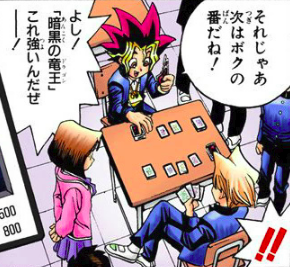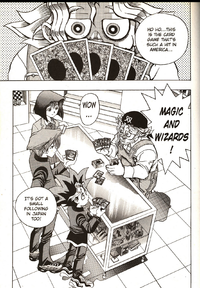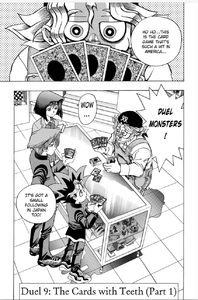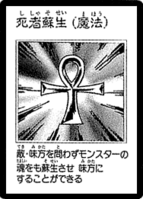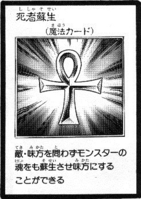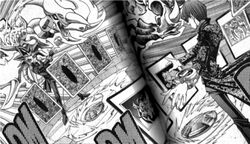Difference between revisions of "Duel Monsters (manga)"
(→Name: images of the same scene using the two names in different printings) |
(→Rules: mostly copied over from the Duel Monsters article, with a few changes) |
||
| Line 46: | Line 46: | ||
==Rules== | ==Rules== | ||
===Basic=== | ===Basic=== | ||
| − | + | The following rules were used in ''Duel Monsters'' first appearance and [[Death-T]]. | |
| + | |||
* There are two players in each Duel.<ref name="d 9" /> | * There are two players in each Duel.<ref name="d 9" /> | ||
* Each player makes a Deck using 40 cards.<ref name="d 9" /> The Decks are shuffled before a Duel.<ref name="d 36">{{chapter|Yu-Gi-Oh!|36|ref}}</ref> | * Each player makes a Deck using 40 cards.<ref name="d 9" /> The Decks are shuffled before a Duel.<ref name="d 36">{{chapter|Yu-Gi-Oh!|36|ref}}</ref> | ||
| Line 65: | Line 66: | ||
* Spell Cards can be played face-down on the [[field]] until they are ready to be used.<ref name="d 10" /> | * Spell Cards can be played face-down on the [[field]] until they are ready to be used.<ref name="d 10" /> | ||
* Monsters with the power of flight have a 35% chance to evade ground-based attacks, allowing them to avoid being destroyed when battling monsters with the same ATK.<ref name="d 37" /> | * Monsters with the power of flight have a 35% chance to evade ground-based attacks, allowing them to avoid being destroyed when battling monsters with the same ATK.<ref name="d 37" /> | ||
| + | |||
| + | ===Standard=== | ||
| + | The '''Standard''' rules contained the basic rules, with some additional ones. These were used during the [[Japanese National Duel Monsters Championship]] and the [[Duelist Kingdom]] tournament. | ||
| + | |||
| + | * More types of cards were added, including [[Equip Card|Equip]],<ref>{{chapter|Yu-Gi-Oh!|70|ref}}</ref> [[Trap Card|Trap]]<ref name="d 1">{{chapter|Yu-Gi-Oh!|60|ref}}</ref>, [[Illusion Card|Illusion]]<ref name="d 62">{{chapter|Yu-Gi-Oh!|62|ref}}</ref> and [[Virus Card|Virus]].<ref>{{chapter|Yu-Gi-Oh!|110|ref}}</ref> | ||
| + | ** Trap Cards can be activated during either players' turn in response to certain actions. | ||
| + | ** Virus Cards are used to destroy cards in the opponent's Deck using a virus.<ref name="d 102">{{chapter|Yu-Gi-Oh!|102|ref}}</ref> | ||
| + | * Monsters were divided into Monster and [[Magician (Alignments)|Magic-User]] Cards.<ref name="d 61">{{chapter|Yu-Gi-Oh!|61|ref}}</ref> This distinction is rarely mentioned. | ||
| + | * Monsters and Magic-Users have [[Attribute]]s, each with strengths and weaknesses.<ref name="d 61" /> | ||
| + | ** The Attributes of Magic-Users are [[Black Magic (Alignment)|Black Magic]], [[White Magic (Alignment)|White Magic]], [[Demon Magic (Alignment)|Demon Magic]] (called "Demons & Devils" in the English manga) and [[Illusion Magic (Alignment)|Illusion Magic]] (called "Illusionists" in the English manga). Black Magic is strong against White Magic, White Magic is strong against Demon Magic, Demon Magic is strong against Illusion Magic, Illusion Magic is strong against Black Magic.<ref name="d 62" /> | ||
| + | ** Other Attributes include [[Earth (Alignment)|Earth]], [[Thunder (Alignment)|Lightning]], [[Water (Alignment)|Water]], [[Fire (Alignment)|Fire]], [[Forest (Alignment)|Wood]],<ref name="d 66">{{chapter|Yu-Gi-Oh!|66|ref}}</ref> [[LIGHT|Light]]<ref>{{chapter|Yu-Gi-Oh!|110|ref}}</ref> and [[DARK|Dark]].<ref name="d 37" /> Lightning is strong against Water.<ref name="d 61" /> | ||
| + | ** What happens when monster of opposing Attributes battle is inconsistent. Sometimes the monster of the weaker Attribute loses half its ATK.<ref name="d 61" /> More often, nothing happens. | ||
| + | ** On the [[Duelist Kingdom (island)|Duelist Kingdom island]], monsters received [[Field Power Bonus]]es depending on the terrain they were played in.<ref name="d 65">{{chapter|Yu-Gi-Oh!|65|ref}}</ref> | ||
| + | *** [[Forest (terrain)|Forest]] strengthens the Wood Attribute and the [[Insect]] and [[Beast]] Types.<ref name="d 66">{{chapter|Yu-Gi-Oh!|66|ref}}</ref> | ||
| + | *** [[Meadow|Grassland]] strengthens the Fire Attribute and the [[Warrior]] and [[Beast-Warrior]] Types.<ref name="d 66" /> | ||
| + | *** [[Mountain (terrain)|Mountains]] strengthens the Lightning Attribute and the [[Winged Beast]], [[Dragon]] and Birdfolk Types.<ref name="d 66" /> | ||
| + | *** [[Wasteland (terrain)|Wasteland]] strengthened the Earth Attribute and the [[Dinosaur]] and [[Zombie]] Types.<ref name="d 66" /> | ||
| + | *** [[Ocean]] strengthened the Water Attribute and the [[Fish]] and [[Sea Serpent]] Types.<ref name="d 66" /> | ||
| + | *** [[Graveyard (terrain)|Graveyard]] strengthened the Zombie Type.<ref>{{chapter|Yu-Gi-Oh!|89|ref}}</ref> | ||
| + | * Monsters can be played in face-down Attack Mode.<ref name="d 61" /> However, this is rarely done. | ||
| + | * Monsters can be [[Fusion Summon|fused]] together using the card "[[Polymerization (manga)|Polymerization]]".<ref>{{chapter|Yu-Gi-Oh!|68|ref}}</ref> "Polymerization" and the Fusion Material monsters are still in play after a Fusion. The Fusion Monster does not have a physical card.<ref name="d 105">{{chapter|Yu-Gi-Oh!|105|ref}}</ref> | ||
| + | * [[Ritual Spell Card]]s can be used to [[Ritual Summon]] a monster by sacrificing monsters that meet a certain criteria.<ref>{{chapter|Yu-Gi-Oh!|108|ref}}</ref> | ||
| + | |||
| + | ===Expert=== | ||
| + | [[File:D-041 Duel Disk Battle.jpg|thumb|right|250px|[[Dark Yugi (manga)|Dark Yugi]] and [[Seto Kaiba (manga)|Kaiba]] using the Expert rules]] | ||
| + | The '''Expert''' rules were used with the first version [[Duel Disk]]s. This alters many of the previous rules and adds more. | ||
| + | * Each player can only hold five cards at a time.<ref name="d 105" /> | ||
| + | ** If a player has five cards at the start of their turn, they cannot draw a card.<ref name="d 105" /> | ||
| + | ** If a player has feer than five cards at the start of their turn, they draw until they have five. | ||
| + | * The Duel Disk contains five stages; the main card stage and four sub card stages. The main card is played in the main stage. All the player's other cards in their hand are played in the sub stages.<ref name="d 102" /> | ||
| + | * Monsters in the main monster can be played in Attack or Defense Mode. Monsters in the sub stages are all in Attack Mode.<ref name="d 102" /> | ||
| + | * The main card gets special abilities and powers from the sub cards.<ref name="d 102" /> | ||
| + | * Sub cards are face-down until used or attacked.<ref name="d 102" /> | ||
| + | * Sub cards can be flipped face-down and shuffled.<ref name="d 102" /> | ||
| + | * A player's main monster can attack their opponent's main monster or any of the opponent's face-down cards. Normal rules of battle are applied if they attack a Monster Card. Non-Monster Cards are automatically destroyed if they are attacked.<ref name="d 102" /> | ||
| + | |||
| + | ===Super Expert=== | ||
| + | The '''Super Expert''' rules were introduced in the [[Battle City]] tournament. They are based on the standard rules, contain additional rules and alter previous ones. The Expert rules do not apply in Super Expert. | ||
| + | * Each player starts with 4000 Life Points.<ref name="d d 94">{{chapter|Yu-Gi-Oh! Duelist|94|ref}}</ref> | ||
| + | * A player's hand cannot contain more than seven cards<ref name="d d 94" /> | ||
| + | * High [[Level]] monsters require sacrifices to be Summoned. | ||
| + | ** [[Level]] 5 and 6 monsters require one sacrifice.<ref name="d d 94" /> | ||
| + | ** Level 7 or higher monsters require two sacrifices.<ref name="d d 94" /> | ||
==History== | ==History== | ||
Revision as of 00:43, 8 October 2023
Duel Monsters, known as Magic & Wizards (マジック
This is the very first incarnation of Duel Monsters and served as the basis for many of the variations to follow, including the Yu-Gi-Oh! Official Card Game and Yu-Gi-Oh! Trading Card Game.
Duel Monsters debuted when the manga had an episodic format and featured a different game nearly every week. However due to its popularity among readers, it ended up becoming the main game played throughout the series.
Contents
Name
The game is called Magic & Wizards or M&W for short in the Japanese manga. However, due to its similarity to Magic: The Gathering, the game was renamed to Duel Monsters in other media. Despite this, the Japanese manga continued to call the game Magic & Wizards throughout its run.
When the English manga was first printed in the Shonen Jump magazine, it used the name Magic and Wizards.[1] However when those chapters were reprinted in volumes, the name was changed to Duel Monsters.
Cards
Layout
The layout of the cards is simplistic compared to other iterations of the game. All cards are white with black border around them. While concepts like Attribute and Type exist, they are not reflected on the card's layout. Sometimes cards have effects not printed on them, such as "Time Wizard".
The rules on the placement of elements on a card are not strictly enforced. The rules below are generally followed, but numerous exceptions exist.
Initially the layout consisted of the following in this order:
- The card name
- For non-Monster Cards, the card's type appeared in brackets after the name. This did not include the word "Card". e.g. a Spell Card would say "(Spell)", not "(Spell Card)".
- For Monster Cards, a number of stars indicating the Level appeared on the same row as the name or the next row, depending on space.
- The card's artwork, surrounded by a border.
- For Monster Cards, a row with the word "ATK" (
攻 撃 力 ), followed by the ATK value and a row with the word "DEF" (守 備 力 ), followed by the DEF value. - Text for the card's effect
- If a Monster Card has an effect, its ATK and DEF are put on the same row, making space for the effect to be printed above them.
- Card's have a prismatic corner stamp, but these are not visible to the reader.[1]
Beginning with "Challenge!!", the layout changed a bit:
- The word "Card" appears after the card type. e.g. "(Spell Card)". The card type is completely omitted for a number of cards.
- Level and card type are more frequently placed on the line after the name.
- On Monster Cards, the card's effect is placed above ATK and DEF.
Rules
Basic
The following rules were used in Duel Monsters first appearance and Death-T.
- There are two players in each Duel.[1]
- Each player makes a Deck using 40 cards.[1] The Decks are shuffled before a Duel.[2]
- There are two kinds of cards; Monster Cards and Spell Cards.[3]
- Each player starts with 2000 Life Points. If a player runs out of Life Points they lose.[1]
- At the beginning of a Duel, each player draws five cards, which become their hand.[4]
- The players take turns. Each turn the turn player draws one card from their Deck.[1]
- The turn player can Summon cards from their hand in Attack or Defense Mode.[1] Attack Mode is vertical. Defense Mode is horizontal.[3]
- The turn player can attack with Attack Mode monsters.[3]
- If an Attack Mode monster battles another Attack Mode monster, the monster with the lower ATK is destroyed and its controller loses Life Points equal to the difference.[3]
- When Attack Mode monsters with equal ATK battle, both are destroyed.
- If an Attack Mode monster attacks a Defense Mode monster and its ATK is higher than the defending monster's DEF, the defending monster is destroyed and no Life Points are lost.[3]
- If an Attack Mode monster attacks a Defense Mode monster and its ATK is lower than the defending monster's DEF, neither monster is destroyed and the controller of the attacking monster loses Life Points equal to the difference in the ATK and DEF.[3]
- If a player does not have a monster to defend from their opponent's monsters attack, the monster's ATK is deducted from the defenseless player's Life Points.[1]
- Destroyed cards go to the Graveyard.[3]
- The turn player can activate Spell Cards from their hand.[4]
- Spell Cards cannot battle, but can be used to affect other cards or the players.[3]
- Spell Cards can be played face-down on the field until they are ready to be used.[3]
- Monsters with the power of flight have a 35% chance to evade ground-based attacks, allowing them to avoid being destroyed when battling monsters with the same ATK.[4]
Standard
The Standard rules contained the basic rules, with some additional ones. These were used during the Japanese National Duel Monsters Championship and the Duelist Kingdom tournament.
- More types of cards were added, including Equip,[5] Trap[6], Illusion[7] and Virus.[8]
- Trap Cards can be activated during either players' turn in response to certain actions.
- Virus Cards are used to destroy cards in the opponent's Deck using a virus.[9]
- Monsters were divided into Monster and Magic-User Cards.[10] This distinction is rarely mentioned.
- Monsters and Magic-Users have Attributes, each with strengths and weaknesses.[10]
- The Attributes of Magic-Users are Black Magic, White Magic, Demon Magic (called "Demons & Devils" in the English manga) and Illusion Magic (called "Illusionists" in the English manga). Black Magic is strong against White Magic, White Magic is strong against Demon Magic, Demon Magic is strong against Illusion Magic, Illusion Magic is strong against Black Magic.[7]
- Other Attributes include Earth, Lightning, Water, Fire, Wood,[11] Light[12] and Dark.[4] Lightning is strong against Water.[10]
- What happens when monster of opposing Attributes battle is inconsistent. Sometimes the monster of the weaker Attribute loses half its ATK.[10] More often, nothing happens.
- On the Duelist Kingdom island, monsters received Field Power Bonuses depending on the terrain they were played in.[13]
- Forest strengthens the Wood Attribute and the Insect and Beast Types.[11]
- Grassland strengthens the Fire Attribute and the Warrior and Beast-Warrior Types.[11]
- Mountains strengthens the Lightning Attribute and the Winged Beast, Dragon and Birdfolk Types.[11]
- Wasteland strengthened the Earth Attribute and the Dinosaur and Zombie Types.[11]
- Ocean strengthened the Water Attribute and the Fish and Sea Serpent Types.[11]
- Graveyard strengthened the Zombie Type.[14]
- Monsters can be played in face-down Attack Mode.[10] However, this is rarely done.
- Monsters can be fused together using the card "Polymerization".[15] "Polymerization" and the Fusion Material monsters are still in play after a Fusion. The Fusion Monster does not have a physical card.[16]
- Ritual Spell Cards can be used to Ritual Summon a monster by sacrificing monsters that meet a certain criteria.[17]
Expert
The Expert rules were used with the first version Duel Disks. This alters many of the previous rules and adds more.
- Each player can only hold five cards at a time.[16]
- If a player has five cards at the start of their turn, they cannot draw a card.[16]
- If a player has feer than five cards at the start of their turn, they draw until they have five.
- The Duel Disk contains five stages; the main card stage and four sub card stages. The main card is played in the main stage. All the player's other cards in their hand are played in the sub stages.[9]
- Monsters in the main monster can be played in Attack or Defense Mode. Monsters in the sub stages are all in Attack Mode.[9]
- The main card gets special abilities and powers from the sub cards.[9]
- Sub cards are face-down until used or attacked.[9]
- Sub cards can be flipped face-down and shuffled.[9]
- A player's main monster can attack their opponent's main monster or any of the opponent's face-down cards. Normal rules of battle are applied if they attack a Monster Card. Non-Monster Cards are automatically destroyed if they are attacked.[9]
Super Expert
The Super Expert rules were introduced in the Battle City tournament. They are based on the standard rules, contain additional rules and alter previous ones. The Expert rules do not apply in Super Expert.
- Each player starts with 4000 Life Points.[18]
- A player's hand cannot contain more than seven cards[18]
- High Level monsters require sacrifices to be Summoned.
History
Duel Monsters was a big hit in the United States and started to gain a following in Japan too.[1]
The game featured a number of valuable cars, with one fan in America alleged to have sold his house to pay for a single card. Initially "Blue-Eyes White Dragon" was considered to be one of the most powerful cards, so overpowered that production was ceased, causing it to gain a high monetary among collectors.[1] Four copies were known to exist. They fell into the hands of collectors in the United States, Germany, and Hong Kong and Sugoroku Mutou in Japan.[19]
Seto Kaiba's attempt to steal the "Blue-Eyes White Dragon" from Sugoroku Mutou resulted in him being challenged to a Shadow Game of Duel Monsters by Dark Yugi. In this game, the monsters came to life as they were Summoned.[1] On defeat, Kaiba was subjected to a Penalty Game, resulting in him imagining he was trapped inside a card, causing him to reside in the World of Duel Monsters, where he suffered the Experience of Death at the hands of monsters.[3]
Kaiba invented the Solid Vision technology and Battle Boxes, which created 3-D simulations of cards, as players played Duel Monsters, recreating what he witnessed in the Shadow Game. And allowed him to inflict a reconstruction of the Experience of Death on the loser.[19]
References
- ↑ a b c d e f g h i j k Yu-Gi-Oh! Duel 9: "The Cards with Teeth (Part 1)"
- ↑ Yu-Gi-Oh! Duel 36: "Battle Beyond Hope"
- ↑ a b c d e f g h i j Yu-Gi-Oh! Duel 10: "The Cards with Teeth (Part 2)"
- ↑ a b c d Yu-Gi-Oh! Duel 37: "To the Death!!"
- ↑ Yu-Gi-Oh! Duel 70 (Duelist Duel 11): "Things that Don't Change"
- ↑ Yu-Gi-Oh! Duel 60 (Duelist Duel 1): "Challenge!!"
- ↑ a b Yu-Gi-Oh! Duel 62 (Duelist Duel 3): "Countdown!!"
- ↑ Yu-Gi-Oh! Duel 110 (Duelist Duel 51): "Toons Attack!"
- ↑ a b c d e f g Yu-Gi-Oh! Duel 102 (Duelist Duel 43): "A Close Fight!"
- ↑ a b c d e Yu-Gi-Oh! Duel 61 (Duelist Duel 2): "Don't Draw That Card!!"
- ↑ a b c d e f Yu-Gi-Oh! Duel 66 (Duelist Duel 7): "The Trap"
- ↑ Yu-Gi-Oh! Duel 110 (Duelist Duel 51): "Toons Attack!"
- ↑ Yu-Gi-Oh! Duel 65 (Duelist Duel 6): "Let the Duel Begin!"
- ↑ Yu-Gi-Oh! Duel 89 (Duelist Duel 30): "Duel Without End"
- ↑ Yu-Gi-Oh! Duel 68 (Duelist Duel 9): "Demon Lightning"
- ↑ a b c Yu-Gi-Oh! Duel 105 (Duelist Duel 46): "No Mercy"
- ↑ Yu-Gi-Oh! Duel 108 (Duelist Duel 49): "The First Stages of Fear!"
- ↑ a b c d Yu-Gi-Oh! Duel 153 (Duelist Duel 94): "Duel of Vengeance!"
- ↑ a b Yu-Gi-Oh! Duel 27: "Project Start!"
